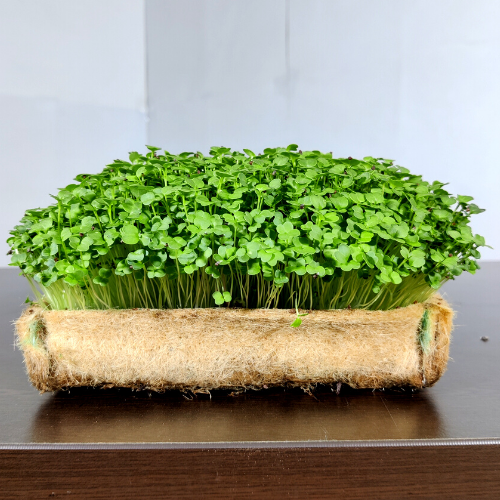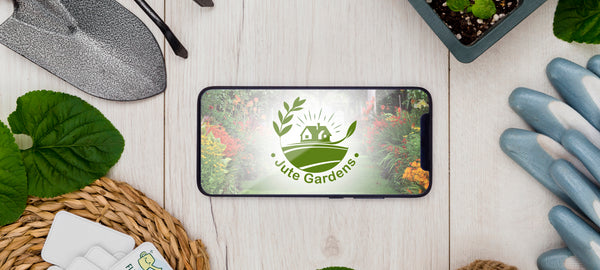
Unlocking the Nutritional Powerhouse: All About Microgreens
Unlocking the Nutritional Powerhouse: All About Microgreens

Microgreens, the young vegetable greens we harvest before they mature fully, have revolutionized the way we think about nutrition and our home gardens, especially in the kitchen, they stand out not just for their petite size and vivid colors but for their aromatic flavors and densely packed nutrients, including essential minerals like potassium, iron, zinc, magnesium, and copper. Despite their size, microgreens are giants in the world of nutrition, offering more vitamins and antioxidants than their mature counterparts in broccoli, basil, arugula, and radish, making them a powerhouse of health benefits, rich in nutrition and antioxidants.
Their ease of cultivation and the convenience of growing them indoors make microgreens an excellent choice for city dwellers interested in sustainability and locally produced seasonal vegetables, acting as an urban cultivator. This article will explore the incredible world of microgreens, covering topics from their nutritional benefits to how to incorporate them into your diet and tips for growing your vibrant indoor garden. We will delve into why these tiny but mighty greens are not only a boon for our health but also for the planet, emphasizing their nutritional value.
The Nutritional Power of Microgreens
Microgreens, those vibrant young greens harvested just after their first true leaves develop, are not only a visual treat but a nutritional powerhouse. Let's delve into the specifics of what makes these tiny greens so beneficial, exploring what are microgreens, microgreens nutrition, and their overall nutrition.
High Nutritional Value
Microgreens are exceptionally rich in various nutrients. They pack a potent punch of vitamins and minerals, including potassium, iron, zinc, magnesium, and copper, essential for maintaining a healthy body. Notably, they contain higher levels of these nutrients compared to their mature counterparts. For instance, the concentration of antioxidants, which play a crucial role in reducing oxidative stress and inflammation in the body, can be up to nine times higher in microgreens than in mature greens. This makes them an excellent addition to any diet, contributing to overall health and the prevention of chronic diseases, thanks to their rich nutrition and antioxidants.
Specific Nutrients and Health Benefits
Certain varieties of microgreens are particularly noteworthy for their health benefits:
- Broccoli Sprouts: Known for their high levels of sulforaphane, a compound that has been shown to have cancer-fighting properties, broccoli sprouts are among the most beneficial microgreens.
- Red Cabbage: These vibrant microgreens help in reducing LDL cholesterol and liver cholesterol levels, which are crucial for maintaining heart health.
- Dietary Fiber: Microgreens are a good source of fiber, which aids in digestion and acts as a prebiotic, supporting beneficial gut bacteria.
Safe Consumption and Growth
While microgreens are generally safe to eat, it's important to ensure they are grown under safe conditions to avoid contamination. Using seeds from reputable sources and clean growing mediums can help minimize the risk of harmful bacteria. Regular consumption of these nutrient-dense plants can be linked to the health benefits of microgreens, emphasizing their nutritional value, and reduced risks of major health issues such as obesity, heart disease, and diabetes.
Incorporating microgreens into your diet not only boosts your nutritional intake but also supports sustainable eating habits, particularly when using an urban cultivator. This approach aligns with both enhancing nutrition and promoting green living, and garden-to-table freshness especially when grown at home using an urban cultivator, their ease of cultivation and minimal space requirements make them an ideal choice for urban gardeners looking to enhance their diet with fresh, nutrient-rich foods.
Popular Varieties of Microgreens
Microgreens, those vibrant, nutrient-packed young shoots of vegetables and herbs, come in a delightful array of varieties, each offering unique flavors, textures, and nutritional benefits. Among the most popular types, we find arugula, basil, broccoli, and cilantro, which are cherished not only for their distinctive tastes but also for their health advantages. These varieties, along with kale, mustard, red cabbage, pea shoots, and sunflower, make up a broad palette that caters to diverse culinary needs and aesthetic preferences, showcasing the richness of plants like arugula and other vegetables.
The range of microgreens extends further into less common but equally fascinating types such as amaranth, chard, quinoa, spinach, and an assortment of alliums like chives, garlic, and onions. Even more exotic choices include carrot, celery, dill, fennel, and chicory, as well as lettuce, radicchio, and a variety of herbs like mint, rosemary, sage, and oregano. These microgreens not only add a splash of color and burst of flavor to dishes but also enhance them with significant nutritional value, embodying the essence of nutritious plants like spinach.
Each variety of microgreens is distinct, with differences in appearance, flavor, and nutritional content that reflect their unique plant characteristics and unique phytochemical compositions. For instance, micro broccoli and micro wasabi mustard are known for their intense flavors and health benefits, while more unusual varieties like pink radish and onion microgreens offer a unique twist to traditional greens, showcasing the versatility of plants in culinary applications.
Growing Microgreens at Home
Starting your own microgreen garden indoors offers a sustainable and cost-effective way to enhance your diet with fresh, nutrient-rich greens. Here's a step-by-step guide to help you cultivate a flourishing garden.
Step-by-Step Guide to Growing Microgreens at Home
- Select Your Seeds and Supplies: Begin by choosing high-quality seeds from reputable sources to minimize the risk of contamination. You will also need a growing medium or matYou'll need quality soil, growing containers or trays, a spray bottle for watering, and a sharp knife or scissors for harvesting, ensuring your garden has the best foundation for growth.
- Prepare the Growing Medium: Choose high-quality soil, which is ideal for microgreens. Ensure the soil is moist but not soggy to prevent mold issues. If using a growing mat, soak it with water and place it in your container, creating an optimal environment for plant growth.
- Sow Your SeedsEvenly distribute the seeds over the surface of your growing medium. For smaller seeds like turnips, use less planting density compared to larger seeds. Cover the seeds lightly with soil or place them strategically to ensure optimal plant development.
- Ensure Proper Light and Water: Microgreens do not need light for germination but require bright light for growth. After germination, place your trays near a window or under a grow light to ensure your plants receive enough light. Water the seeds daily to keep the soil moist, using a gentle approach to nurture the plant growth. Use a spray bottle to avoid disturbing the seeds.
- Monitor Growth and Prevent Mold Stack trays during germination to help the plants develop strong roots. Avoid overwatering and ensure proper humidity controls are in place to create an optimal growing environment. Regular inspection is necessary to check for mold and ensure the plants are properly hydrated, maintaining a healthy growth environment for your microgreens.
- Harvest Your Microgreens: Microgreens are typically ready to harvest about 3-10 days after they are exposed to light, depending on the variety. Use a clean, sharp knife or scissors to harvest, use a clean pair of scissors to cut the greens just above the soil line. Avoid washing the microgreens to maintain their quality and longevity, ensuring your plants remain fresh.
By following these steps, you can enjoy the benefits of fresh, ho reduce the environmental footprint associated with store-bought greens.
Incorporating Microgreens into Your Diet
Microgreens, with their compact size and nutrient density, are incredibly versatile and can be incorporated into a wide range of dishes, enhancing both the nutritional value and flavor of meals. Here are practical ways to integrate these small but mighty greens into your daily diet, boosting your nutrition.
Versatile Uses in Everyday Meals
- Enhance Your Salads and Sandwiches: Toss a handful of arugula or radish microgreens into your salad for a nutrient kick or use them as a fresh, crispy addition to sandwiches and wraps instead of lettuce, enhancing the salad's nutrition and taste.
- Boost Your Breakfast: Start your day healthily by sprinkling microgreens over scrambled eggs. Consider adding microgreens to your morning routine by mixing them into omelets. They blend seamlessly with breakfast favorites, adding color, texture, and a boost of nutrition.
- Creative Cooking: Stir microgreens into your soups, stews, or pasta dishes. Garnish your dishes with microgreens just before serving. This not only preserves their nutrients but also adds a burst of freshness and nutrition to hearty meals.
Innovative Recipes with Microgreens
- Smoothies and Juices: For a nutrient-packed beverage, blend mild microgreens like pea shoots or broccoli micros into your morning smoothies. They provide a subtle flavor while boosting the fiber and vitamin content.
- Pesto and Dips: Create a vibrant microgreen pesto. Experiment by substituting traditional basil with microgreens for a fresh twist on a classic pesto recipe. This plant-based pesto can be used in pasta dishes, spread on bread, or as a dip for vegetables, offering a novel way to enjoy your plants.
- Snacking and Garnishes: Use sturdy microgreens like pea shoots or sunflower shoots as a nutritious snack or garnish on dishes like grilled meats, risottos, or grilled vegetables for added texture and flavor, making them a perfect addition for those exploring plant-based options.
Engaging Family in Healthy Eating
Inviting children to participate in growing and harvesting microgreens can spark their interest in nutrition and healthy eating. This hands-on experience not only educates them about where food comes from but also makes them more likely to enjoy greens in their meals.
By incorporating microgreens into various dishes throughout the day, you can significantly enhance your intake of essential nutrients while enjoying the fresh, intense flavors these greens offer. Whether used in traditional recipes or as innovative culinary creations, microgreens provide a simple yet effective way to boost your nutrition.
The Benefits of Growing Microgreens Indoors
Microgreens present a highly viable option for urban and peri-urban gardeners due to their short growth cycle and minimal requirement for external nutrients. These tiny yet mighty plants thrive in limited spaces, making them perfect for apartment dwellers or those with small gardening areas. Their rapid growth cycle allows for quick harvests, often within just a few weeks, ensuring a steady supply of fresh plants. This is particularly beneficial in urban settings where space and soil quality can be limiting factors.
Additionally, the cost-effectiveness of growing microgreens at home cannot be overstated. Typically, microgreens can be quite costly when purchased at grocery stores, often priced around $8 for just 2-4 ounces. By choosing to cultivate these greens at home, you not only cut down on grocery bills but also gain the satisfaction of growing your food. This makes microgreens an economical choice for enhancing your nutrition without straining your budget.
By integrating microgreens into your indoor gardening routine, you're not just contributing to your health but also adopting a more sustainable lifestyle. This practice reduces the need for packaging and long-distance transportation associated with store-bought greens, further aligning with nutrition and eco-friendly living principles. Growing microgreens indoors offers a practical and rewarding way to access nutritious, fresh food while supporting environmental sustainability.
Harvesting and Storage Tips for Microgreens
Harvesting Techniques for Optimal Freshness
To ensure the best quality and longevity of your microgreens, it's crucial to harvest them correctly. Begin by watering the plants 12 to 24 hours before harvesting to ensure they are fully hydrated. Use a sharp knife to make clean cuts, which helps reduce stem damage and quickens deterioration. If your microgreens are wet on the outside, gently pat them dry to prevent spoilage and extend their shelf life. Handling your microgreens is also vital to avoid bruising and damage, preserving their aesthetic appeal, texture, and plant vitality.
Effective Storage Methods
Once harvested, storing microgreens properly is key to maintaining their freshness and nutritional value. Start by storing your microgreens in a shallow plastic container that matches the size of your harvest to reduce condensation and allow some airflow. This setup helps in preventing the microgreens from becoming too moist, which can lead to quicker spoilage. To further control moisture, place a paper towel over the greens before sealing the container with a lid. This method helps absorb excess moisture while keeping the microgreens dry and fresh. Store the container in your refrigerator, ideally in the produce drawer, to maintain an optimal temperature of 33 and 40 degrees Fahrenheit.
Prolonging Shelf Life
To maximize the shelf life of your microgreens, it is essential to manage the storage environment meticulously. Avoid placing microgreens near ethylene-producing fruits and vegetables as ethylene can accelerate ripening and spoilage. For those storing multiple types of produce, consider using separate compartments to protect your valuable vegetables with ethylene-absorbing bags to maintain the freshness of your microgreens. Additionally, ensure that your storage containers provide minimal air space. Employing humidity controls to further reduce the risk of condensation and moisture buildup, which are primary contributors to spoilage, is a smart strategy. By following these guidelines, you can enjoy your home-grown microgreens for a longer period, enhancing your meals with their freshness and nutritional benefits.
Conclusion
Throughout this exploration of microgreens, we've traversed from their nutritional zeniths to the simplicity and gratifications of cultivating them in the smallest of urban spaces. These tiny greens, dense in nutrients and rich in flavor, not only enrich our plates but also our health, embodying a perfect blend of convenience and wellness. By embedding them in our daily diets - from wholesome smoothies to garnished gourmet dishes - we unlock an array of health benefits that surpass their diminutive size, illustrating that good things indeed come in small packages.
As we continue to navigate through the realms of sustainable living and mindful eating, the journey of integrating microgreens into our lives offers a straightforward yet profound step towards enhancing our well-being and that of the planet. They stand as a testament to the power held in our choices, no matter how small, to craft a healthier, more sustainable world. For those inspired to embark on this green-thumbed venture, it's heartening to know that starting your own microgreen garden is just a click away.Shop microgreen kits. Join the burgeoning community of urban gardeners reaping the myriad benefits these verdant little wonders have to offer, and cultivate your own garden oasis.
FAQs
1. Do microgreens offer more nutritional benefits than mature plants?
Yes, microgreens are indeed more nutritious compared to their mature counterparts, containing up to 40% more phytochemicals. These tiny greens are packed with high concentrations of vitamins, minerals, and other beneficial nutrients that support overall health, making them a powerhouse of nutrition.
2. What are the key nutritional benefits of microgreens?
Microgreens are rich in several essential nutrients, including vitamins A, C, E, K, and B6, as well as folate. They also provide significant amounts of iron and protein. Additionally, microgreens contain healthy fats such as omega-3 and omega-6 fatty acids, which are crucial for brain health, and they offer a complete set of amino acids, underscoring their nutritional value.
3. Which microgreens have anti-inflammatory properties?
Chive microgreens, along with other members of the allium family like garlic, shallots, scallions, onions, and leeks, are known for their anti-inflammatory and antioxidant properties. These microgreens are also rich in various vitamins, making them an excellent choice for reducing inflammation and bolstering your nutrition and antioxidant intake.
4. What are considered the healthiest types of microgreens?
Some of the healthiest microgreens, including broccoli, watercress, red cabbage, kale, spinach, sunflower, pea, and radish, each offer unique health benefits, making them a valuable addition to a balanced diet. Incorporating these nutrition-packed greens, especially spinach, into your meals can significantly enhance your overall health and well-being.
References
[1] - https://www.healthline.com/nutrition/microgreens
[2] - https://www.medicalnewstoday.com/articles/316075
[3] - https://www.ncbi.nlm.nih.gov/pmc/articles/PMC9864543/
[4] - https://www.webmd.com/diet/what-to-know-about-microgreens
[5] - https://www.isu.edu/media/libraries/rural-health/microgreens/Microgreen-Nutritional-Profile.pdf
[6] - https://www.gardenary.com/blog/the-pros-and-cons-of-growing-microgreens-at-home
[7] - https://www.youtube.com/watch?v=lJK1js5Z1aE
[8] - https://www.marthastewart.com/8297647/microgreens-and-how-to-use-them
[9] - https://extension.psu.edu/a-step-by-step-guide-for-growing-microgreens-at-home
[10] - https://www.feastingathome.com/how-to-grow-microgreens/
[11] - https://www.bootstrapfarmer.com/blogs/microgreens/top-ten-microgreens
[12] - https://www.cleaneatingkitchen.com/best-microgreens/
[13] - https://grocycle.com/types-of-microgreens/
[14] - https://www.quora.com/What-are-the-benefits-of-growing-microgreens-at-home-using-a-kit
[15] - https://www.youtube.com/watch?v=eFPf54eCuB4
[16] - https://www.youtube.com/watch?v=dtvuMNVLISo
[17] - https://www.robinettefarms.com/post/10-easy-ways-to-eat-micro-greens

